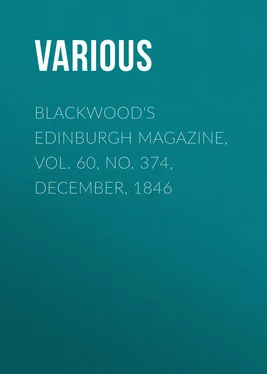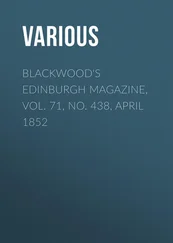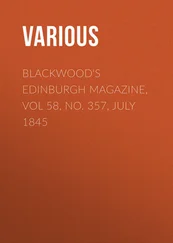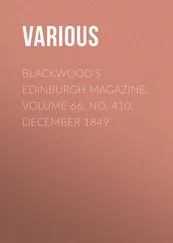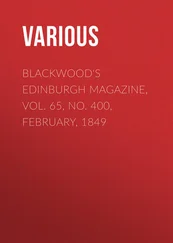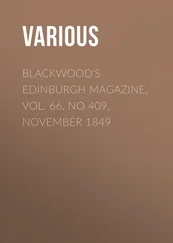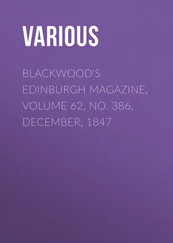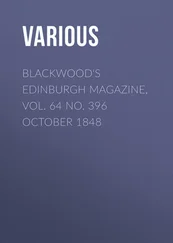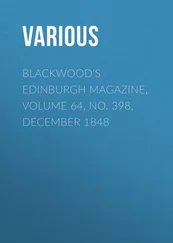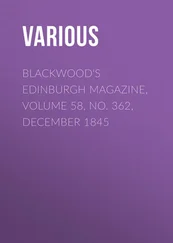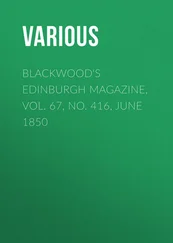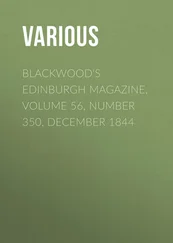Various - Blackwood's Edinburgh Magazine, Vol. 60, No. 374, December, 1846
Здесь есть возможность читать онлайн «Various - Blackwood's Edinburgh Magazine, Vol. 60, No. 374, December, 1846» — ознакомительный отрывок электронной книги совершенно бесплатно, а после прочтения отрывка купить полную версию. В некоторых случаях можно слушать аудио, скачать через торрент в формате fb2 и присутствует краткое содержание. Издательство: Иностранный паблик, Жанр: periodic, foreign_edu, Путешествия и география, на английском языке. Описание произведения, (предисловие) а так же отзывы посетителей доступны на портале библиотеки ЛибКат.
- Название:Blackwood's Edinburgh Magazine, Vol. 60, No. 374, December, 1846
- Автор:
- Издательство:Иностранный паблик
- Жанр:
- Год:неизвестен
- ISBN:нет данных
- Рейтинг книги:4 / 5. Голосов: 1
-
Избранное:Добавить в избранное
- Отзывы:
-
Ваша оценка:
- 80
- 1
- 2
- 3
- 4
- 5
Blackwood's Edinburgh Magazine, Vol. 60, No. 374, December, 1846: краткое содержание, описание и аннотация
Предлагаем к чтению аннотацию, описание, краткое содержание или предисловие (зависит от того, что написал сам автор книги «Blackwood's Edinburgh Magazine, Vol. 60, No. 374, December, 1846»). Если вы не нашли необходимую информацию о книге — напишите в комментариях, мы постараемся отыскать её.
Blackwood's Edinburgh Magazine, Vol. 60, No. 374, December, 1846 — читать онлайн ознакомительный отрывок
Ниже представлен текст книги, разбитый по страницам. Система сохранения места последней прочитанной страницы, позволяет с удобством читать онлайн бесплатно книгу «Blackwood's Edinburgh Magazine, Vol. 60, No. 374, December, 1846», без необходимости каждый раз заново искать на чём Вы остановились. Поставьте закладку, и сможете в любой момент перейти на страницу, на которой закончили чтение.
Интервал:
Закладка:
The church of St Kund, at Odense, was erected in honour of King Kund, murdered in the year 1100 in the church of St Alben, at Odense. The bones of the canonised were immured in the wall over the altar. Many sovereigns have been interred here. Indeed, it is a singular fact that the respective burial-places of every Christian king of Denmark, from the earliest times up to the present day, are traced without the slightest difficulty; whilst every heathen sovereign, of whom any historical record remains, lies buried beneath a mound within sight of Seire, the old heathen capital of the country. St Kund's church is of Gothic architecture. Amongst the many paintings that decorate its walls is one of a female, known as Dandserinden , or "The Dancer." She is the heroine of a tradition, met with under slightly modified forms in various parts of Denmark. It is to the following effect: – A young lady, of noble family, went accompanied by her mother to a ball; and being an indefatigable dancer, she declared to her parent, who bade her take rest, that she would not refuse to dance even though a certain gentleman himself should ask her as a partner. The words were scarcely uttered before a finely dressed youth made his appearance, held out his hand, and, with a profound obeisance, said, "Fair maiden, let us not tarry." The enthusiastic dancer accepted the proffered hand, and in an instant was with the moving throng. The music, at that moment, seemed inspired by some invisible power – the dancers whiled round and round, on and on, one after the other, whilst the standing guests looked upon all with dread horror. At length, the young lady grew pale – blood gushed from her mouth – she fell on the floor a corpse. But her partner, (we need not say who he was,) first with a ghastly smile, then with a ringing laugh, seized her in his arms, and vanished with her through the floor. From that time she has been doomed to dance through the midnight hours, until she can find a knight bold enough to tread a measure with her. Regarding the sequel, however, there are a number of versions.
Mr Kohl's volume adverts cursorily to the many institutions still existing in Denmark, which owe their origin to the days of Roman Catholicism, and have been formed upon the model of Catholic establishments. Several Frökenstifts , or lay nunneries, are still in being. They are either qualifications of some ancient monastic foundation, or they have been endowed from time to time by royal or private munificence. Each house has a lady superior, who is either chosen by the king or queen, or succeeds to the office by right of birth – some noble families having, in return for large endowments, a perpetual advowson for a daughter of the house. At these Frökenstifts , none but ladies of noble birth can obtain fellowships. As a large number of such noble ladies are far from wealthy, a comfortable home and a moderate salary are no small advantages. A constant residence within the cloister is not incumbent upon the "fellows;" but a requisition, generally attached to each presentation, obliges them to live in their stift for a certain number of weeks annually. The practice of founding institutions for ladies of noble birth has risen naturally in a country where family is every thing, and wealth is comparatively small: where it is esteemed less degrading to live on royal bounty than to enter upon an occupation not derogatory to any but noble blood. The system of pensioning in Denmark is a barrier to real national prosperity. Independence, self-respect, every consideration is lost sight of in the monstrous notion, that it is beneath a high-born man to earn his living by an honourable profession. Diplomacy, the army, and navy, are the three limited careers open to the aristocracy of Denmark; and since the country is poor, and the nobility, in their pride, rarely or never enrich themselves by plebeian alliances, it follows, of course, that a whole host of younger brothers, and a countless array of married and unmarried patricians, must fall back upon the bounty of the sovereign, administered in one shape or another. The Church and Law are made over to the middle classes. To such an extent is pride of birth carried, that without a title no one can be received at Court. In order, therefore, to admit such as are excluded by the want of hereditary rank, honorary but the most absurd titles are created. " Glatsraad ," " Conferenceraad ," Councillor of State, Councillor of Conference, carry with them no duties or responsibilities, but they obtain for their possessors the right of entrée , otherwise unattainable. In Germany, the titles of the people, from the under-turnpike-keeper's-assistant's lady, up to the wife of the lord with a hundred tails, are amusing enough. They have been sufficiently ridiculed by Kotzebue; but the distinctions of Denmark go far beyond them. A lady, whose husband holds the rank of major (and upwards) in the army, or of captain (and upwards) in the navy, or is of noble birth, is styled a Frue ; her daughter is born a Fröken : but the wife of a private individual, with no blood worth the naming in her veins, is simply Madame , and her daughter's Jomfrue . You might as easily pull down Gibraltar as the prejudice which maintains those petty and frivolous distinctions. It is highly diverting to witness the painful distress of Mr Kohl at hearing ladies of noble birth addressed as Frue Brahe , Frue Rosenkrands , instead of by the sublime title of Gnädige Frau , eternally in the mouths of his own title-loving countrymen. It is singular, however, that whilst the Danes are so tenacious of honorary appellations, they are without those constant quantities, the von and de of Germany and France. The Sture , the Axe , the Trolle , and the other nobles who, for ages, lived like kings in Denmark, were without a prefix to their names. Greve and Baron are words of comparatively modern introduction.
There are about twenty high fiefs in Denmark – the title to hold one of these lordships, which bring with them many important privileges, being the possession of a certain amount of land, rated at the value of the corn it will produce. The owners are exempt from all payment of taxes, not only on their fiefs, but on their other lands: they have the supervision of officials in the district: are exempted from arrest or summons before an inferior court, to which the lesser nobility are liable; and they enjoy the right of appropriating to their own use all treasures found under the earth in their lordships. Next to these come the baronial fiefs; then the stammehuser , or houses of noble stock, all rated according to various measures of corn as the supposed amount of the land's produce; all other seats or estates are called Gaarde , Courts, or Godser , estates. The country residences of the nobility are strikingly elegant and tasteful. They are surrounded by lawns and parks in the English fashion, and often contain large collections of paintings and extensive libraries. Along the upper corridors of the country residences of the nobility are ranged large wooden chests, (termed Kister ,) containing the household linen, kept in the most scrupulous order. Many of these Kister are extremely ancient, and richly carved in oak. Every peasant family, too, has its Kiste , which holds the chief place in the sitting-room, and is filled with all the treasure, as well as all the linen, of the household. Amongst other lordly structures, Mr Kohl visited Gysselfelt , 3 3 Whilst in this neighbourhood, Mr Kohl should have explored the Gunderler Wood, where stone circles and earth mounds are yet carefully preserved, marking the site of one of the principal places of sacrifice in heathen times. At Gysselfelt , a lay nunnery exists, founded as recently as the year 1799.
near Nestned in Zealand. It was built in 1540 by Peter Oxe, and still stands a perfect representation of the fortresses of the time. Its fosses yet surround it – the drawbridges are unaltered: and, round the roof, at equal distances, are the solid stone pipes from which boiling water or pitch has often been poured upon the heads of the assailants below. In the vicinity of this castle is Bregentned , the princely residence of the Counts Moltke . The Moltke are esteemed the richest family in Denmark. Their ancestors having munificently endowed several lay nunneries, the eldest daughter of the house is born abbess-elect of the convent of Gysselfelt : the eldest son is addressed always as "His Excellence." The splendid garden, the fine collection of antiquities, the costly furniture and appointments that distinguish the abode at Bregentned send Mr Kohl into ecstasies. He is equally charmed by the sight of a few cottages actually erected by the fair hands of the noble daughters of the House of Moltke. The truth is, Mr Kohl, republican as he is, is unequal to the sight of any thing connected with nobility. The work of a noble hand, the poor daub representing a royal individual, throws him immediately into a fever of excitement, and dooms his reader to whole pages of the most prosaic eloquence.
Интервал:
Закладка:
Похожие книги на «Blackwood's Edinburgh Magazine, Vol. 60, No. 374, December, 1846»
Представляем Вашему вниманию похожие книги на «Blackwood's Edinburgh Magazine, Vol. 60, No. 374, December, 1846» списком для выбора. Мы отобрали схожую по названию и смыслу литературу в надежде предоставить читателям больше вариантов отыскать новые, интересные, ещё непрочитанные произведения.
Обсуждение, отзывы о книге «Blackwood's Edinburgh Magazine, Vol. 60, No. 374, December, 1846» и просто собственные мнения читателей. Оставьте ваши комментарии, напишите, что Вы думаете о произведении, его смысле или главных героях. Укажите что конкретно понравилось, а что нет, и почему Вы так считаете.
